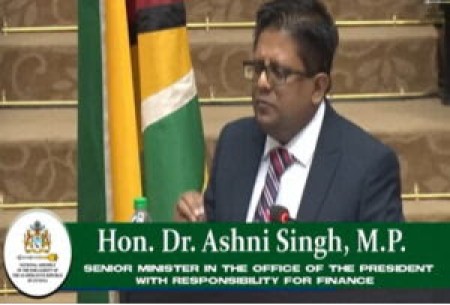GEORGETOWN, Guyana –The Guyana government has signed an agreement with the International Development Association (IDA) to provide financing for a project that will boost the education sector by expanding access to a quality education at the Secondary level as well as to improve technical and vocational training (TVET).
 Established in 1960, IDA, part of the World Bank group, aims to reduce poverty by providing zero to low-interest loans (called “credits”) and grants for programs that boost economic growth, reduce inequalities, and improve people’s living conditions.
Established in 1960, IDA, part of the World Bank group, aims to reduce poverty by providing zero to low-interest loans (called “credits”) and grants for programs that boost economic growth, reduce inequalities, and improve people’s living conditions.
Senior Finance Minister Dr. Ashni Singh told Parliament that the external loan agreement is in the amount of 31,900,000 Special Drawing Rights (SDR), an international reserve asset created by the International Monetary Fund (IMF) to supplement the official reserves of its member countries. One SDT=US$0.578 cents).
Singh told Parliament, which is being boycotted by the opposition, that the project provides for teacher training in on the new curriculum for Grades 7 to 9 including coaching and mentoring programs, the development of and implementation of an instructional leadership and managerial program for principals and provision of technical support;
It will also be used for the financing of learning materials and purchase of textbooks for Grades 7 to 11 in line with the renewed curriculum and with Caribbean Examination Council (CXC) requirements as well as the implementation of targeted interventions to address capacity and demand driven challenges to support student retention and access including the establishment of an early warning system (EWS) to combat dropout at the secondary level, provision of student counselling and guidance and re-enrollment and information campaigns encouraging return of students who have left the education system and promoting retention and
In addition, the project will finance a study of the impact of the coronavirus (COVID-19) pandemic on learning and schooling losses, and to assess the impact of education interventions to recover losses and to further inform targeted interventions.
Singh said that the government has been devising ways in which it can address the problem of learning loss as a result of the lengthy closure of school due to the COVID-19 pandemic which began in early 2020.
He said in September of this year, President Irfaan Ali, while chairing the first leaders’ roundtable on transforming education worldwide, recommitted to making tertiary education free in Guyana by the year 2025.
“He also committed to increasing expenditure on the education sector to twenty percent of the country’s National budget and six percent of its Gross Domestic Product. In September 2021, Education Minister Priya Manickchand highlighted that at least 1,000 primary school pupils from the public-school system had dropped out of school after the first year following the pandemic because the Ministry of Education (MoE) had been forced to close schools and adopt online learning.”
Singh said that it was also noted also that there was a significant drop out rate at the secondary school level where several students who registered for the CXC exams did not turn up to write their exams.
“With schools back in full sessions, government’s aim is to address the learning loss and find ways in which it can rectify the issue and strengthen the teaching and learning environment,” he said, noting that in line with President Ali’s vision to provide world-class education to citizens, GUY$74.4 billion (One Guyana dollar=US$0.004 cents) was budgeted this year for the education sector, an increase from GUY$60.7 billion the previous year.
He said that the 2022 budget measures included an increase in government’s education cash grant to each school child to GUY$30,000, adding that the budget interventions also included an allocation of GUY$6.6 billion for the construction, rehabilitation, extension and maintenance of educational facilities.


